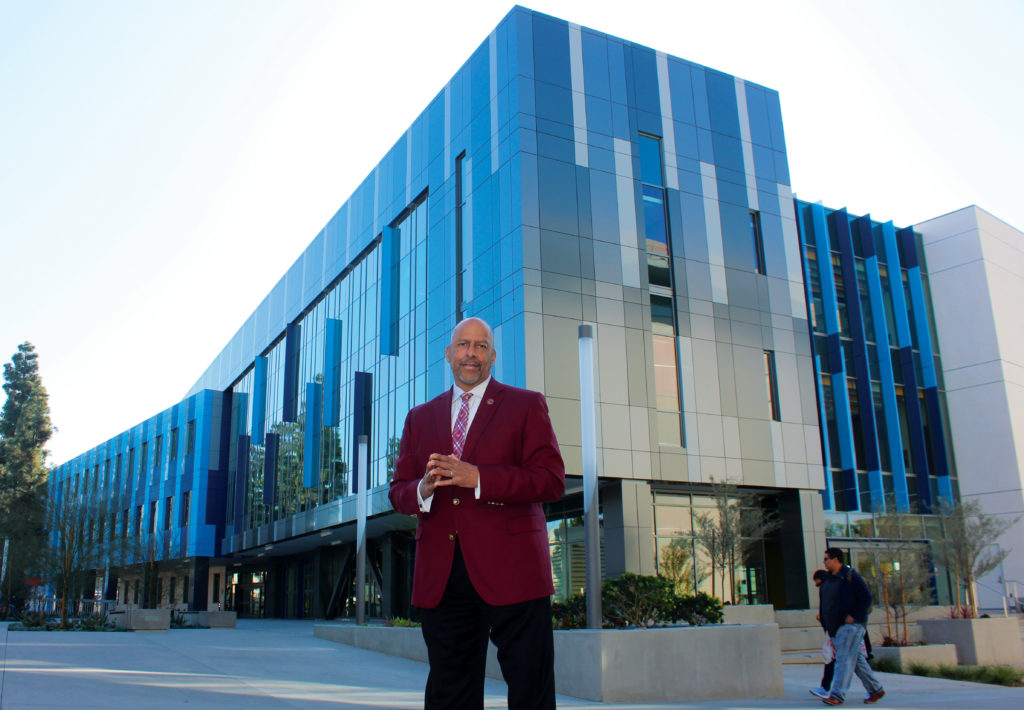Walking across the Cal State Dominguez Hills campus, it’s obvious that change is underway. The university recently completed construction on a new science center. The construction of two more projects, the Innovation and Instruction Building as well as a new student housing facility, is still in progress.

“There’s a lot of excitement and transformation going on here on campus,” CSUDH President Thomas Parham said in a recent interview. Parham, a psychologist by training, was appointed to lead the school in March 2018, and since then has made it his mission to expand the campus’ real estate footprint.
“I’m fond of reminding folks that there’s an old African proverb that says: It is the outer garment that best adorns the inner beauty of the person,” Parham said. “At Dominguez Hills, what we want to make sure is that the university environment is really framed by academic buildings that excite people with just their ambiance and the look that best reflects the genius, the scholarship, the academics that go on inside these walls.”
The new Science and Innovation Building is a particular point of pride for the CSUDH president, who calls it a “game changer” for the school. Completed last month, the building will soon host teaching labs and faculty offices for biology, chemistry and physics.
It will also serve as the first permanent location for the school’s mobile fabrication lab program, which aims to spark interest in the sciences among middle and high school students by offering opportunities to use scientific instruments and experiment with different materials. The laboratories, which usually operate out of movable trailers traveling to various local schools, are part of a network established by Fab Lab, the educational outreach component of MIT’s Center for Bits and Atoms. CSUDH’s program, and its new on-campus location, is sponsored by car manufacturer Toyota, which will see its name prominently displayed in the new center.
According to Parham, the Science and Innovation Building is the school’s first new facility supported by state funds in 25 years.
On the western edge of campus, a new 506-bed student housing complex is rising from the dust. Once completed, the new dormitory will nearly double the school’s residential capacity, which currently stands at 647 bed spaces.
Building more on-campus housing has been a priority for Parham. “I would build 3,000 bed spaces on this campus tomorrow if I could,” he said. The motivation behind this push for more student housing is that keeping students on campus longer will help keep them engaged in their studies, Parham explained.
“If you don’t have to leave at 3 o’clock every day, then you can go work with faculty member X in a lab on your research project, you can be in a mentoring group,” he pointed out. “If we can keep [students] on campus longer, then we expose them to not just the academics of the classroom, but the co-curricular learning opportunities that take place in the residence halls.”
This is especially important for students at CSUDH, many of whom are the first in their family to go to college and come from communities that are underrepresented in academia, Parham noted.
“We have a high underrepresented, minority [student] population, a high first-generation population,” he said. “We train a much broader and diverse swatch of students than a lot of other university systems in the country.”
Helping those students navigate and succeed in higher education involves more effort, Parham said. While he expressed gratitude for the financial commitment Gov. Gavin Newsom has made to the Cal State University system, Parham said he would appreciate more consideration for the cost involved with supporting a student population as diverse as his.
“What it takes for me to educate this crop of folk is much more expensive,” he pointed out.
Preparing students for life after graduation is part of the school’s educational mission. To improve their chances of success in the job market, Parham said CSUDH regularly confers with the business community.
“As we think about training the workforce of tomorrow, we have to get [together] with our partners in business and corporations to say: What is it that you’re expecting? What are the attributes that you’re looking for? Where are we in education missing the mark?” he said. “Our goal is not simply to get students through a major, but to take that major and look at how you can take those skills—both academic and co-curricular—and apply them across a broad category of occupational endeavors.”
One new occupational endeavor that will soon be supported by the school’s curricular offerings is occupational therapy. After receiving approval by the state legislature in August 2019, CSUDH is on its way to becoming the first public university in Southern California to offer a doctorate program in that field.
Together with the new science building, which is scheduled to open this summer, the creation of a doctoral program in occupational therapy marks an important milestone for the school as it celebrates its 60th anniversary this year. Founded in 1960 as “South Bay State College,” the school’s permanent campus in Carson opened in October 1968, just a few months after the city was officially incorporated.
“The 60th anniversary is not just a placeholder to mark the legacy that we have been blessed to inherit. It really is a trampoline that allows us to project into the future where we want the campus to go, not just in the next 60 years, but certainly in the short interim,” Parham said. “We are an urban and metropolitan university. And if I have my way, I want us to be a model urban university in the nation. And I think we have the potential to be that.”
Editor’s note: A previous version of this story misstated CSU Dominguez Hill’s new doctoral program as being in “occupational psychology,” instead of “occupational therapy.”
